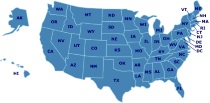Map & Globe Skills
The ability to properly read maps and globes gives you an opportunity to explore different places, people, and cultures in the real world. These resources, teaching tips, and ideas will help make it easy for your children to learn to read and understand maps and globes.
Activities & Experiments
Name That Country Game
"Dear Pen Pal, Konnichi wa! We've been to see Mt. Fuji. Name my country! Sayonara, Michiko." Challenge your group with this fast-paced geography game, created in 1992 by Educational Insights, Inc. Everyone begins at the post office. Players twirl a finely printed spinner (built into the game board itself) to select one of 60 countries. If the player can correctly identify the country's location on the board's numbered map, he or she may advance along the path to the finish. Bonus moves are won by landing on "postcard" spaces, listening to the clues on one of the 40 postcards, and correctly identifying the pen pal's country. (The sample postcard above came from Japan.) A more challenging game can be achieved by requiring players to name the country's capital; answers are provided. --Liane Thomas
Postcard Kids
Geography Postcard Kids Project started for homeschooled children around the world in October of 2002. It is intended to help enhance geographic studies by sending postcards from their local area to other postcard kids around the world.
Great States Board Game
What is the capital of NJ? Where is the Football Hall of Fame? These are just a few of the hundreds of questions players are asked as they adventure around the USA discovering state attractions and landmarks, capitals, state abbreviations, state locations and more. In order to answer the questions on the cards, players must look closely at the colorful USA map game board, becoming familiar with the geography of the country. Players must hurry to find the answers as the mechanical timer ticks. Contents: Game board, 100 Figure cards, 100 Fact cards, 100 Find cards, 1 spinner, 1 mechanical timer, and game rules. Duration of Play: 20 minutes. 2-6 players.
Teaching Tips & Ideas
How I Teach a Large Family in a Relaxed, Classical Way: History
A look at teaching history across several grades using the classical method of education and a rotation of history every four years.
Knowledge Quest
Knowledge Quest offers historical outline maps and timelines designed for the interactive study of world history and geography.
Featured Resources
As an Amazon Associate, we earn from qualifying purchases. We get commissions for purchases made through links on this site.
Montessori Play And Learn : A Parent's Guide to Purposeful Play from Two to Six
We all want the best possible starts in life for our children, and one of the best possible starts in life, educationally, is the "method" pioneered by Maria Montessori and taught successfully today throughout the world.Now, Lesley Britton, the leading Montessori practitioner in England for more than twenty years, will show parents how to bring Montessori home. If you would like to facilitate the development of your child's unique personality, make it possible for him to develop to his full inte...
Waldorf Education: A Family Guide
Waldorf Education finds itself catapulted from its humble beginnings 80 years ago into the midst of the central educational and social issues of this decade.What draws parents and educators toward Waldorf Education today? "Waldorf Education - A Family Guide" offers a "first look" for parents and educators into the history, philosophy, curriculum, and traditions of this unique education. This comprehensive book is a collection of articles describing the world of Waldorf Education - the fastest gr...
Elementary Geography
Elementary Geography is a reprint of the original work by Charlotte Mason. It includes her ideas about teaching children about their world, with poetry selections throughout the book. Explores ideas of place from space to our earth, seasons, map making, and topography. Written in a pleasing conversational style, it is useful for understanding teaching methods, memorization, and copy work.
Pecci Reading Method: At Last! A Reading Method for Every Child
At Last! A Reading Method for Every Child offers a balanced approach with intensive phonics and literature-based reading instruction. This is a simple method of teaching reading, with lots of supplemental materials. Get product information here.
Serving Homeschooled Teens and Their Parents (Libraries Unlimited Professional Guides for Young Adult Librarians Series)
This guide for librarians addresses the needs of homeschooled teens and how a library can meet those needs. Includes ideas like developing a homeschool resource and book collection to creating special homeschool programs. While this book was written for library staff, it is also an insightful guide into how homeschoolers and libraries can work together.






